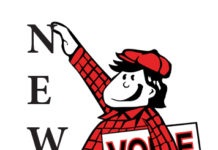
Photo by Jamie Kimball
By D’Ann Tedford
At a high school hangout one day in the sixties, a guy offered each of us a cigarette from his pack. I was 16 and accompanied by an older Tahoma student. “She doesn’t smoke,” he said as he reached for the Camels.
“Yes, I’ll have one,” I interrupted. I obviously had a common teenage trait, disliking others to speak on my behalf. My decision that day put into action what could have become a lifetime addiction.
I now find anti-nicotine television commercials so compelling. The tobacco industry’s honesty is being dictated by the federal government as part of a financial settlement for accountability. Those ads are heartbreaking. One woman is on a breathing machine due to lung cancer; after her surgery, another uses modern technology to express herself with distorted language coming from a speaking device. A man has essentially lost his teeth and use of his mouth after throat and gum cancer. Cigarette companies have been mandated by the government to disclose that they purposely raised nicotine content to force-feed addiction. In movies from my era, the 1960’s, most teenage role models and nearly every Academy Award winning actor/actress is smoking.
According to recently published current statistics, only 14% of adults in the United States are smokers. Perhaps a Pete Ryan came into the non-smoker lives. He sure impacted mine. His story and mine: In 1959 Pete Ryan was hired as a Tahoma High School staff member. I was a THS student in 1959. “Mr. Ryan” was not only a skilled Tahoma counselor, but teacher and championship basketball coach as well. After high school and following my first seven-year teaching job, I returned to Tahoma in 1977. I was a new-hire staff member. It was a joy replacing my retiring journalism teacher, Bill Ziegner, in his (and my) old classroom – top floor of the old, old, older Tahoma High School on SE 216th Street. For the next five years, 1977 until 1982, when he retired, I referred to teacher “Mr. Ryan,” as my co-worker, “Pete.”
Pete had witnessed a strategically planned and successful challenge to smokers while at his summer vacation job in the wheat fields in 1976. It was the same year that American Cancer Society established the third Thursday in November as “The Great American Smokeout.”
Three months into that school year, Pete put into action at Tahoma the same wheat field teaser he had witnessed. He challenged smoking staff members to join the Smokeout and quit nicotine for the day. That challenge effectively put a stop sign on my pathway to a lifetime habit. I was 20 years into addiction with a 10-year old daughter who does not recall (thank goodness) ever seeing me smoke those Winstons. The Tahoma School Board challenged staff, school employees, and administrators to quit smoking. It was an “up the ante” plan. Smokers each chipped in $100 to bet they could stop for 24 hours. The payment would be returned to those who were successful. Right off the bat, the challengers surreptitiously caught Tahoma’s business manager smoking. He paid up. The challengers donated half of his money to the American Cancer Society. With his other $50, they bought lunch for themselves while laughing at the business manager’s expense. I, too, took Pete’s challenge. He told me recently that he’d always wondered whether I had quit smoking permanently, but was he cautious in asking. I smiled. He read the answer in my facial expression like any good counselor would.
A former Tahoma District school board member, Chuck Hardaway, remembers taking the stop smoking challenge. He believes that Tahoma was one of the first districts in the state to ban smoking on campus. One of the first steps to quit smoking, according to the Cancer Society, is to identify your trigger; what causes you to automatically light up. If you identify your trigger, the next step is to create pathways around it. For example, is smoking a part of your routine when starting up the car? Does a meal always end by having a smoke? Chuck Hardaway says stress was his trigger, “Stress was a big thing with me. I was in Viet Nam on 100 stress-filled missions. I decided if I could pass the challenge of stress-filled missions, I could also prove I didn’t have to be a stress smoker. I simply created a pledge to myself.” His 101st mission was accomplished. No more smoking.
For me, coffee was the trigger. To give up smoking I knew I’d have to also stop compulsive coffee drinking. I owned up to two addictions. Again, American Cancer Society came to the rescue. They recommend starting with 24 hours of no smoking. Of course, a logical scenario for all of us who wanted to quit meant you’d begin to wonder, “If I can go for one day, how about two; maybe a week; I’ll try a stop-smoking month.” My personality always ceded to success; in this case, ready to win a challenge. After a week of prolifically chewing gum, of using mouthwash, of brushing my teeth many times a day, I finally sipped my Folgers Coffee by changing its taste and texture. I had always needed the mellow cream in my cup but decided on black “as is” instead. It worked. I could now drink coffee despite the image of my peaceful mom with a Salem cigarette in one hand, Redbook magazine in the other, a cup of heavily creamed coffee steaming in front of her. I have now been a non-smoker for three-plus decades. That’s the lifetime impact a Tahoma staff member had on me. November 15th, just four weeks away, is the 2018 Great American Smokeout. So, to you out there, 14% of the U.S. population who are smokers, I promote the Pete Ryan challenge. It sure worked for me.








